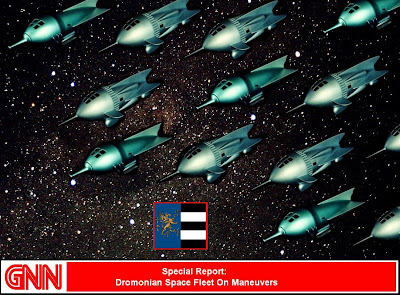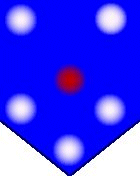
This article discusses the 5th Independent Company of the 3rd Battalion, 2nd Infantry Brigade, Royal Gurkha Rifles. For an illustrated TO&E of one rifle platoon in this company, see my article on the subject in the Gallery and Modeling section STARGUNT.ca.
The Independent Companies of the reformed Gurkha units of the NAC Regular Army provide unparalleled expertise in infantry combat and act as "stiffening elements" for other regular NAC Army or Colonial Militia units. The Independent Companies are almost always deployed as an attached element to units such as the Battalion Battle Groups of the Royal New Anglian Light Infantry. Occasionally, Gurkha Companies will be deployed on their own to one of the NAC colonies to provide a core of expertise for the local Militia.
5 Independent Company has been semi-permanently attached to the 123rd Battalion Battle Group, Royal New Anglian Light Infantry, since their campaign together on Wallace in 2180. Wallace, a relatively new NAC colony in the outrim settled primarily by Scots and Nova Scotians, was only 18 years old at the time of the conflict, and had a small militia and no permanent NAC Army or Marine garrison. During that brief but intense fight, the Battle Group had to put down a mercenary insurrection sponsored by mineral smugglers, later traced to the FSE-Based Association pour le développement de ressource dans l'espace.
5 Independent Company has remained with 123RNALI in the Outrim almost continuously since 2180 on operations against the ESU and FSE forces in the region.
Gurkha Independent Companies are used for several types of operations:
- Reconnaissance
- Skirmishing and Irregular Warfare
- Rapid Reaction and Rapid Deployment
- Counter Insurgency
- Force Enhancement
- Extended Operations (note: these are "regular" fighting operations conducted in areas with long or interdicted lines of communication).
Gurkha Independent Companies are equipped with no integral heavy or complex equipment. These formations have small integral support and logsitics teams, but rely on their "parent" unit for other support in the field (heavy maintenance, etc). Like the Light Infantry, to whom they are often attached, they are often used in situations where lines of communication and supply are long or interdicted, and the demanding maintenance requirements of heavier units would be difficult or impossible to meet.
The Gurkhas are truly light troops, forgoing heavy ballistic armour, most vehicles and most heavy weapons to maintain their flexibility and vaunted speed in battle.
A note about unit designations: It should be noted that the nomenclature used for unit designations in the Independent Companies is reversed to that of much of the rest of the NAC army. Because these companies are tasked as Independent formations and rarely deploy with their parent battalion, they are given a Unit Number designation, instead of the usual letter designation, and their platoons are given letter designations.
Total Strength: 7 Officers, 207 Other Ranks (214 total troops).
Headquarters Platoon (2 Officers, 29 Other Ranks)HQ Section (2 Officers, 6 ORs)
Major OC, Captain 2IC. The HQ section for the Company includes the commander and 2IC, the Company Sergeant Major, an operations staff of three, and two troopers who act as security and runners, if needed.
Quartermaster Section (8 ORs)
Sergeant OC. The QM Section takes care of supplies for the Company, and includes several qualified weapons technicians.
Signals Section (4 ORs)
Sergeant OC. The signallers maintain the company comms net, operate specialized long-distance equipment, and usually include at least one qualified EW operator.
Medical Section (1 Officer, 3 ORs)
WO OC. The Medical Section in an Independent Company is commanded by a senior medic. These specialists are qualified to perform emergency surgery, and can provide most necessary basic medical care.
Recce Section (8 OR)
Sergeant OC. This section is staffed by the members of the company who have demonstrated exemplary skills at being sneaky. They usually deploy as teams of two or four.
Heavy Weapons Platoon (1 Officer, 38 Other Ranks)
HQ Section (1 Officer, 8 ORs)
Lieutenant OC. The HQ section of the Weapons Platoon includes the platoon commander and 2IC, 3 trained Forward Observers, the platoon signals specialist, a SAW gunner, and a medic team of two.
GMS/L Section (10 Ors)
Sergeant OC. The GMS/L section consists of three GMS/L teams, with three troops per team. Each team is able to manpack a GMS/L system with a ground mount and five missiles, in addition to their personal weapons. If the platoon has access to light vehicles, each team will have a separate one and be issued with more ammunition.
RAM Mortar Section (10 ORs)
Sergeant OC. The Mortar Section operates 3 Light RAM mortars, with three troops per mortar. They can manpack the mortars and ammunition, with extra ammunition distributed among the rifle platoon troops if necessary. If the platoon has access to light vehicles, each mortar crew will have a separate one and be issued with more ammunition.
HMG Section (10 OR)
Sergeant OC. The HMG Section operates 3 HMG's, either Automatic Grenade Launchers or RFAC/1 on tripods. Each team of three can manpack their weapon and a limited amount of ammunition, but if the distance traveled is likely to be significant, the Section will carry only one or two weapons and more ammunition. If the platoon has access to light vehicles, this section is usually equipped with two or three.
HQ Section (1 Officer, 5 ORs)
Lieutenant OC. The HQ section includes the officer and platoon senior NCO, a signaller with the Platoon Long Range Tactical Relay Radio Station (PLRTRRS), a SAW gunner, and a medic team of two.
Weapons Section (6 Ors)
Sergeant OC. This section normally carries two GMS/P launchers and six missiles per launcher.
3 x Rifle Sections (8 ORs each)
Sergeant OC. Each Rifle Section includes a SAW gunner and a Marksman, in addition to the riflemen. Gurkha rifle sections are often liberally equipped with IAVRs.





















































































